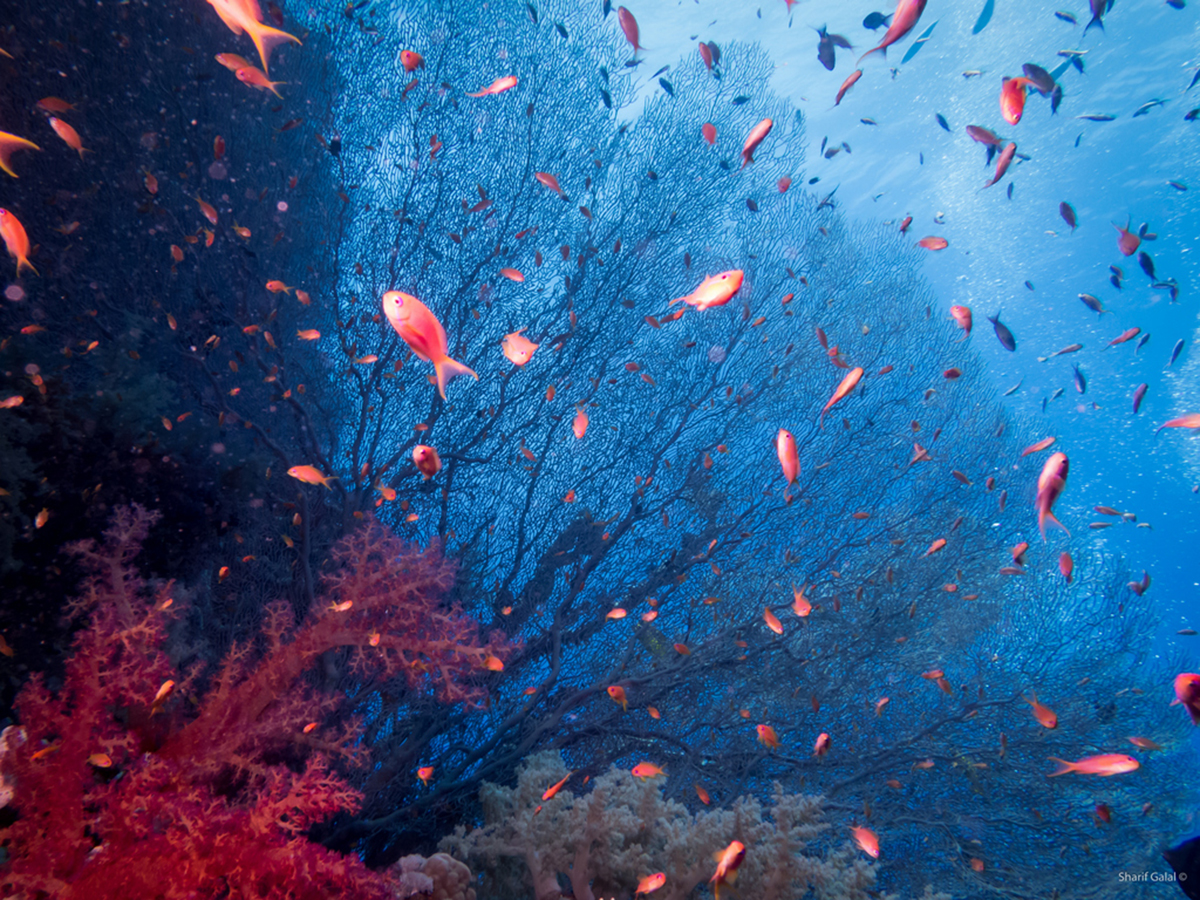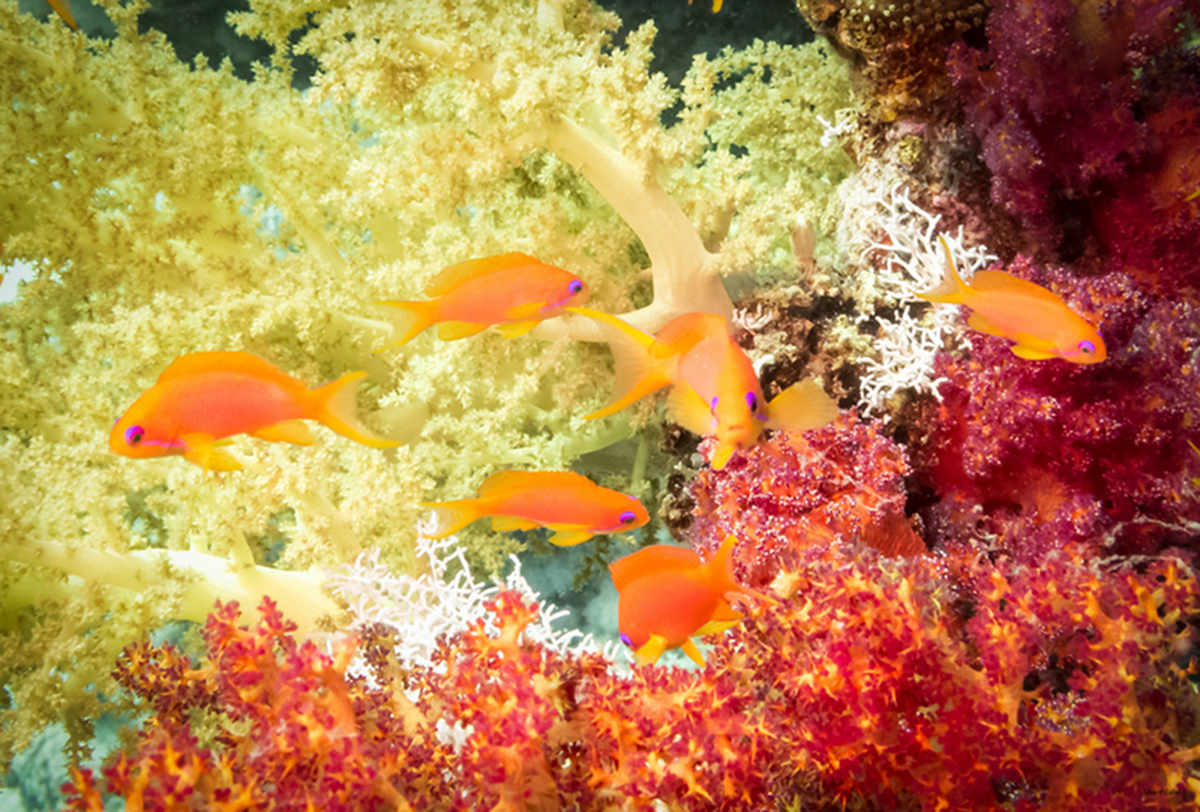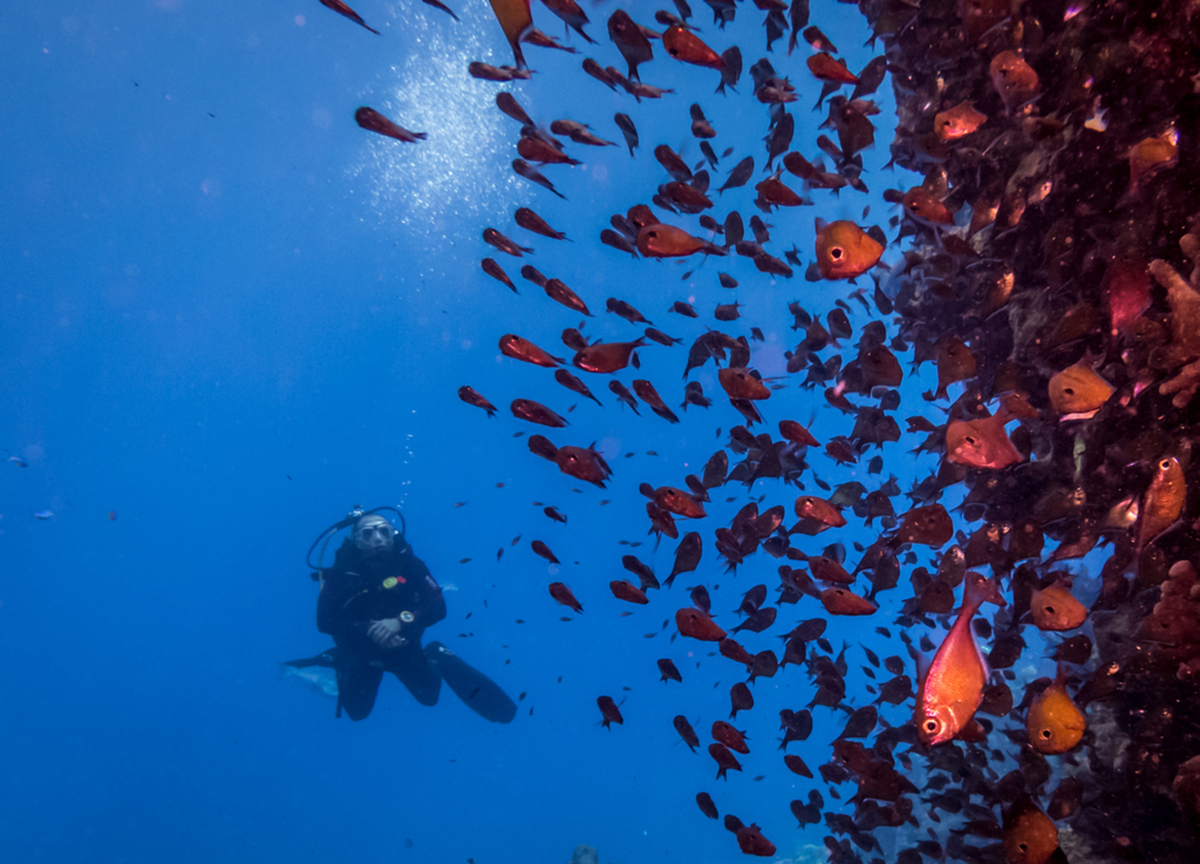
Ras Mohamed Marine National Park - Egypt
by Dr. Sharif Galal ©
January 15, 2016

Arabian Surgeon fish
Words like, gorgonian, clownfish, stingrays and trigger fish may sound like creatures out of fantasy world. However, this fantasy world is in fact real and perhaps, it is the the last fully unexplored territory on our planet - The underwater world.

Black spotted sweetlips
About 70% of planet earth is ocean, and, I used to categorize people into divers and non-divers. If you haven’t dived or at least snorkeled, you haven’t seen 70% of our planet, there is nothing on earth similar to being submerged in water, experiencing the state of zero gravity while getting close to coral reefs, watching fish swirl around you and schooling together to ride the currents, slowly moving manta rays and a lot of other water wonders. It is an orchestra full of different shows, colors while silence play at the background. And for those adventurers who like to return to home with treasures, underwater photography is the secret word.

Butterfly fish feed on coral polyps, small crustaceans and algae
The Red Sea has a unique biodiversity. Since it is narrow and surrounded by desert on both banks, with a rare storms and very little rain, the reefs are subjected to few natural disturbances. Therefore, It is blessed with the most magnificent and unique coral reef of its kind in the world with over a thousand species of fish live in its warm year around crystal clear waters.

Clownfish
The Red Sea is definitively one of the world's major attractions for all marine related activities especially underwater photography and videography.

Coral Garden
Lying in the very southern tip of Sinai Peninsula, Ras Mohamed Marine National Park overlooking the Gulf of Suez on the west and the Gulf of Aqaba to the east, the first and best kept national park in Egypt. Because of its exceptional beauty and scientific significance, the Egyptian Environmental Affairs Agency (EEAA) established the area as a marine reserve for the protection of marine and terrestrial wildlife in 1983. The area can be accessed from both resorts and live aboard diving cruises. Visitors to the park enjoy a rare opportunity for a close-up look at the rich and enchanting life of the red sea, an unforgettable experience for everyone.

Finger corals against very clear pristine water
Surrounded by one of the largest fringing coral reef systems in the world that emerged after a change in the coastline 70,000 years ago, the park is characterized by vertical overhangs at least 100m deep. Thanks to its location, the combining waters of varying salinity from each gulf has resulted in a spectacular array of underwater life, and vibrant sea walls; ideal for some unforgettable scuba diving and underwater filming. You can literally see every single species of fish of the Red Sea in this protected area. On top of that, the reef walls are full of pink, purple and orange soft coral trees and gorgonian. Reef fish are present at Ras Mohammed in abundant numbers throughout the year. The majestic regal angelfish, butterfly fish and spotted sweetlips , all brighten up the underwater scene with its yellow, red and blue patterned bodies. In some months, divers can see hammerheads school of barracuda, snappers and gigantic tuna as well.

Fringing reef Ras Mohammed
A few large caves and overhangs provide cover to several marine creatures. You'll find hundreds of bright orange Jewel Fairy Basslets around gorgonian fans, which are found deeper along the wall.

Fringing reefs Ras Mohammed Park
Heading to shallow water, the wall gives way to a sandy slope scattered with many coral formations that create a huge garden, home to a variety of Arabian Surgeonfish, lionfish, eels, stingrays and groupers. Along sides, Goatfish are foraging in sandy patches in between coral patches, looking for worms and crustaceans found in the loose sand. They are the cleaners of the sandy bottoms.

Gorgonian Fan
This is my first dive in red sea since more than three years. Surprisingly, I found the coral growth to be excellent, with a variety of species that present in a very large number, the ecosystem looks healthier than before! It seems the marine life has thrived in the last four years as a response to the massive decline in tourism in this area after the Arab spring. It is a known fact that bad diving practices significantly affect the marine ecosystem in a negative way.

Map Angelfish
Some tips:
Go to the right place with the right people:
If you want to practice underwater photography, this is the place to go. Avoid getting along with scuba diving boats that are full of divers, they waste time in getting in and out and being in a group does not give you the chance to spend time to find the right composition, light or the interesting subject. I personally go with diving clubs that dedicate trips for underwater photographers where they don’t take more than three divers every dive. They also know where the ideal locations for photography is.

Ras Mohammed
My personal preference is blue world red sea club. They have professional and experienced instructors and underwater photographers who will take you to the magnificent world of diving at Ras Mohamed.

Ras Mohammed
Diving season: All year round.
Closet airport: Sharm Al Shaikh international Airport (SSH)

Top Left: Ras Mohammed Top Right: School of fishes Bottom Left: Stingray Bottom right: Yellow Goatfish

Grouper and Pinky Wall formed of Dendronephtya Klunzingeri a species of soft coral
Getting there: Egypt air operates 8 daily flight from Cairo international airport to (CAI) to Sharm Al Shaikh international airport (SSH). There are several cheap charter flights that goes directly to Sharm al Shaikh from several European cities (Thomas cook, Turkish Air, Monarch, EasyJet, Onur Air).
 Dr Sharif Galal sharifgalalphotography.jpg)
Grape like water filled vesicles of Bubbie Coral (Plerogyra sinuos)
Bibliography:
1- Egyptian Environmental Affairs Agency (EEAA) http://www.eeaa.gov.eg/
2- Discovering the Animals, Plants, and Habitats of Egypt’s Red Sea Reefs. USAID publication
3- Blue World Red Sea Diving Center Sharm El Sheikh http://www.blueworld-redsea.com/
Authors Biography & Contact Information
 Dr. Sharif Galal is a medical doctor and a biotechnology researcher. He received his M.D. from Egypt and his specialty degree in diving medicine from Stellenbosch University- South Africa in addition to a Master’s degree in biomedical sciences from university of Calgary. Apart from medicine and research, Dr. Galal is an amateur underwater photographer, scuba diver and an enthusiastic wildlife and nature advocate. He currently resides in Calgary, Alberta and can be contacted at:
Dr. Sharif Galal is a medical doctor and a biotechnology researcher. He received his M.D. from Egypt and his specialty degree in diving medicine from Stellenbosch University- South Africa in addition to a Master’s degree in biomedical sciences from university of Calgary. Apart from medicine and research, Dr. Galal is an amateur underwater photographer, scuba diver and an enthusiastic wildlife and nature advocate. He currently resides in Calgary, Alberta and can be contacted at:
E-mail: Sharif.galal@icloud.com
Website: www.facebook.com/sharifgalalphotography
Click on the buttons below and share this site with your friends